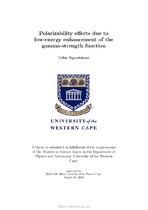| dc.description.abstract | Physics is the study of natural phenomena. Nuclear physicists have since the
discovery of the nucleus been working on understanding its dynamics. The nuclear
chart, analogous to the periodic table of elements, is illustrated in Fig. 1.1
and color coded according to decay modes. Several theoretical models, based
on various hypothesis, have been developed during the years in order to understand
nuclear phenomena such as nucleon-nucleon (n-n) interactions, binding
energies, radii, excited states, etc. Unfortunately, no-unique model is actually
able to grasp all nuclear phenomena at the desired level of accuracy.
Among the di erent models, we notice that two distinct hypotheses can be used
to describe nuclear properties. Firstly, the independent particle shell model
(IPSM) + the n-n residual interaction, which assumes that a nucleon moves
independently in a potential generated by other nucleons. Secondly, the macroscopic
models, where a nucleus is considered as a whole, i.e. neutrons and protons
behave cooperatively and are mutually coupled to each other; highlighting
the short-ranged character of the nuclear force. The liquid-drop model is an example
of such macroscopic models. Re nement of these models is dependent on
experimental observations that are better detailed for nuclei along the line of -
stability, making up a small fraction of the known isotopes, as shown in Fig. 1.1.
In practice, various techniques for studying exotic nuclei up to neutron and
proton drip-lines have been devised, including the use of radioactive ion beams.
However, the main challenges are the synthesization and short lived periods
of these exotic nuclei resulting in insu cient data collection from which the
characteristics and structural information are extracted. In general, nuclei have
unique structures represented by a particular con guration as given by the shell
model (SM). These structures impact a number of physical quantities, e.g. transition
probabilities, cross sections and photon-strength functions. Experimental
methods such as Coulomb excitation or electromagnetic radiation are used to
probe these structures without invoking the nuclear force. | en_US |

